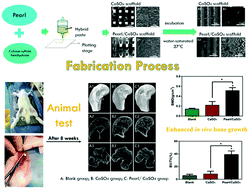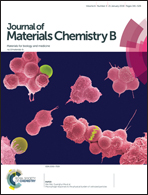3D printing of pearl/CaSO4 composite scaffolds for bone regeneration
Abstract
The development of biomaterials with high osteogenic ability for fast osteointegration with a host bone is of great interest. In this study, pearl/CaSO4 composite scaffolds were fabricated using three-dimensional (3D) printing, followed by a hydration process. The pearl/CaSO4 scaffolds showed uniform interconnected macropores (∼400 μm), high porosity (∼60%), and enhanced compressive strength. With CaSO4 scaffolds as a control, the biological properties of the pearl/CaSO4 scaffolds were evaluated in vitro and in vivo. The results showed that the pearl/CaSO4 scaffolds possessed a good apatite-forming ability and stimulated the proliferation and differentiation of rat bone mesenchymal stem cells (rBMSCs), as well as giving a better expression of related osteogenic genes. Importantly, micro-computed tomography and histology of the critical-sized rabbit femoral condyle defects implanted with the scaffolds illustrated the osteogenic capacity of the pearl/CaSO4 scaffolds. New bone was observed within 8 weeks. The bone-implant contact index was significantly higher for the pearl/CaSO4 scaffolds implant than for the CaSO4 scaffolds implant, indicating that the pearl/CaSO4 scaffolds would be promising implants for bone regeneration.



 Please wait while we load your content...
Please wait while we load your content...